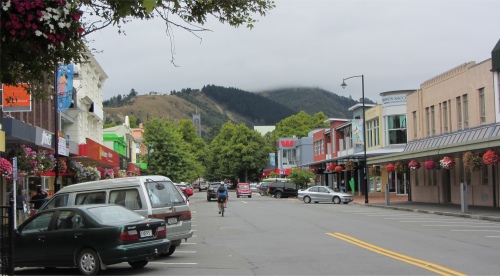 Trafalgar Street |
The road around to Nelson took me through Motueka, and then along the coast to Mapua. A few kilometres inland and I would have been travelling through the Upper Moutere wine region. From Mapua I had a splendid view across the Waimea Estuary to the pine draped Rabbit Island with its endless stretch of beaches, before I swept into the city of Nelson, nestled on the coast between the Arthur and Richmond ranges.
I picked up a campsite close to the city centre, and even closer to Nelson hospital; handy if I go down with the yellow-spotted sandfly disease. The guy who ran the site took me through to his office. I was instantly mesmerised by his hair. It was wiry and had the same colour as the Grey River; chocolate-grey. It just didn't look real to me.
The chap's name was Geert, and hard to pronounce, the "G" sounding like a gutteral "H". He was Dutch and went by the name of Gary on site since nobody could pronounce his real name. He kindly gave me a map and pointed out the places of interest on it.
 South Street |
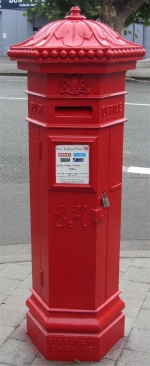 Postbox |
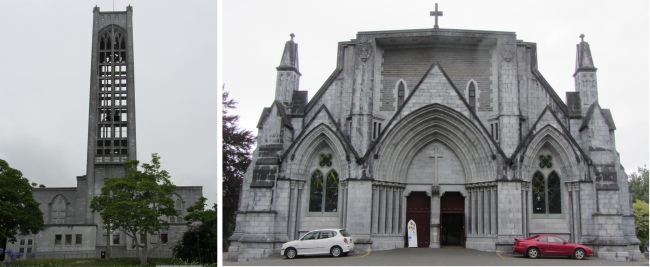 Christ Church Cathedral |
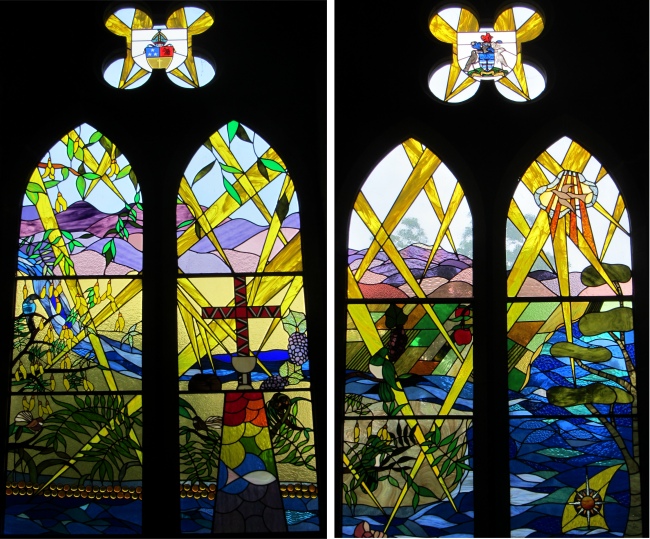 Christ Church Cathedral Windows |
I sauntered down to the olde-worlde, historic South Street. Here, a row of quaint workers' cottages stood, allegedly built between 1863 and 1867, and reputed to be the oldest fully intact street in New Zealand, though I vaguely remember having heard that said of somewhere else.
A stone throw away from South Street, a hill was sited, on which the grim, grey-stone Christ Church Cathedral gazed down Trafalgar Street towards the sea. The construction of this building started in 1924, but lack of funds brought about modifications to the design, and the final hybrid was completed in 1965, though the tower still looked as though it was under construction. Indeed to me it resembled a fire-station practice tower. I climbed up the granite steps made form Tonga granite, a brief reminder of the Tonga Quarry that I passed yesterday. The impressive stained-glass windows at the front of the building made up for the ugly exterior.
Inside, the building was mostly grey, apart from the pews and beautiful windows. One thing I had never seen before in a cathedral was a labyrinth on the floor. Over the centuries, labyrinths have been a feature of many cathedrals, one of the best remaining examples dates from the Middle Ages and is found in Chartres Cathedral in northern France. On the floor of Christ Church Cathedral they have reproduced a classic seven circuit labyrinth.
 Labyrinth |
Unlike a maze, labyrinths have only one path, there are no dead ends. It has a single circuitous path that winds into the centre. From a religious or meditative viewpoint, there are generally three stages to the walk: releasing on the way in, receiving in the centre and returning, that is, taking back out into the world that which you have received.
It was partially covered by a piano when I spotted it, but a couple coming along wanted to walk the labyrinth, so I helped one of the cathedral workers to move it. I fell into conversation with the worker, and asked him, "What is this grey stone that the building is made up from?" It was local granite, whose name escapes me. He took me across to one of the pillars near the Chancel. The side nearest the Nave was smooth granite. On the Sanctuary side, the colour was almost the same, but the texture was totally different. It was concrete and obviously part of the hybrid construction.
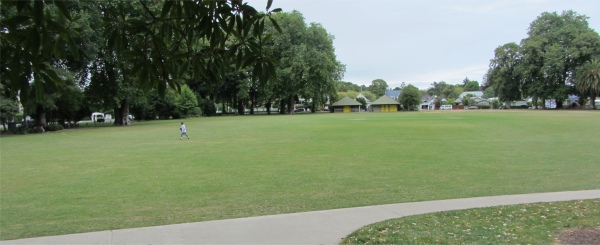 Botanical Reserve - Site of New Zealand's First Game of Rugby |
Across the Maitai River lay the Botanical Reserve, which saw New Zealand's first ever game of rugby being played out in 1870. Charles Monro was born at Waimea West in 1851 and entered Nelson College in 1861 where he remained until 1865. In 1867 he set out for England with the intention of entering the army. In preparation for this he attended Christ's College in London where he learnt the game of rugby. Returning to New Zealand, he brought the game with him and is considered the founder of rugby in New Zealand.
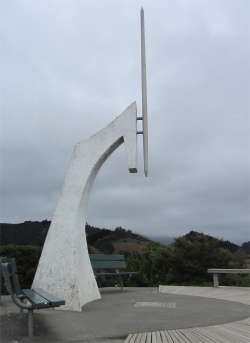 Centre of New Zealand |
The Maori version is slightly different. A long time ago Kupe was returning to the North Island after visiting the Nelson region. Two of his men, Pani and Kereopa, decided to return to the idyllic bay to live and absconded with the daughter of Kupe, setting out in two waka (canoes). Kupe was extremely angry and set off in hot pursuit. The two fugitives tried various ploys to impede Kupe such as offering karakia (prayers) to their atau (gods and spirits) to invoke storms, reefs and whirlpools. None of these tactics slowed Kupe so they threw his daughter overboard, diverting Kupe to rescue her. The incensed Kupe nearly caught the men as they neared Whakatu (Nelson) but they sped up and Pani escaped out into Tasman Bay while Kereopa headed towards the shallows. Kereopa, seeing that Kupe was almost upon him, called to the atau to form a barrier. The barrier grew out of cliffs at Horoirangi (Mackay's Bluff) apace with the two canoes as they headed towards land. Kupe had no time to get around the end of the bank, giving Kereopa just enough time to land and escape inland to the south. Kupe put about to pursue Pani, who invoked the atua to impede Kupe with taniwha and storms. However, it was the waka of Pani that came to grief in the terrible rips as Kupe chased him past the northern end of Rangitoto ki te Tonga (D'Urville Island).

